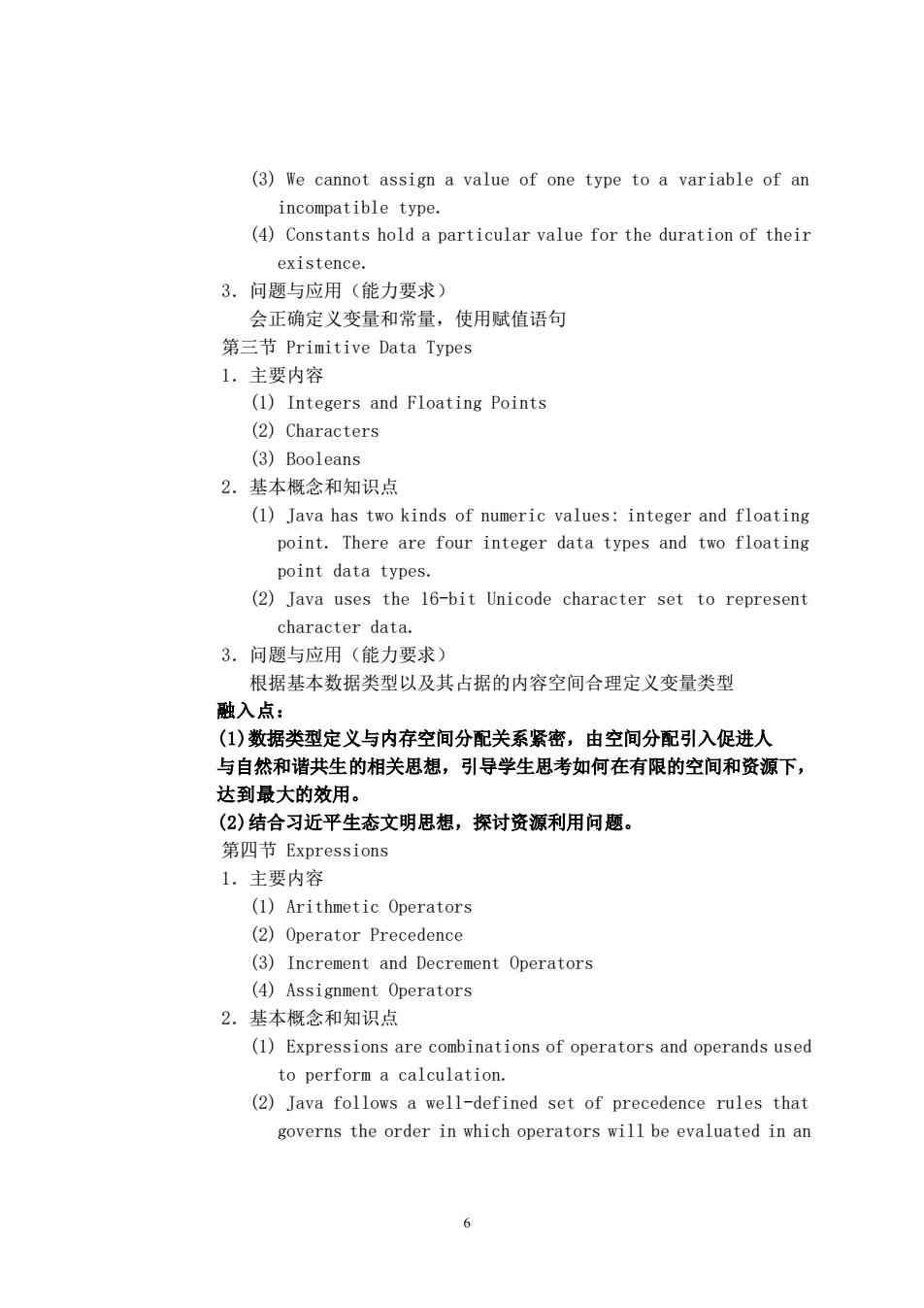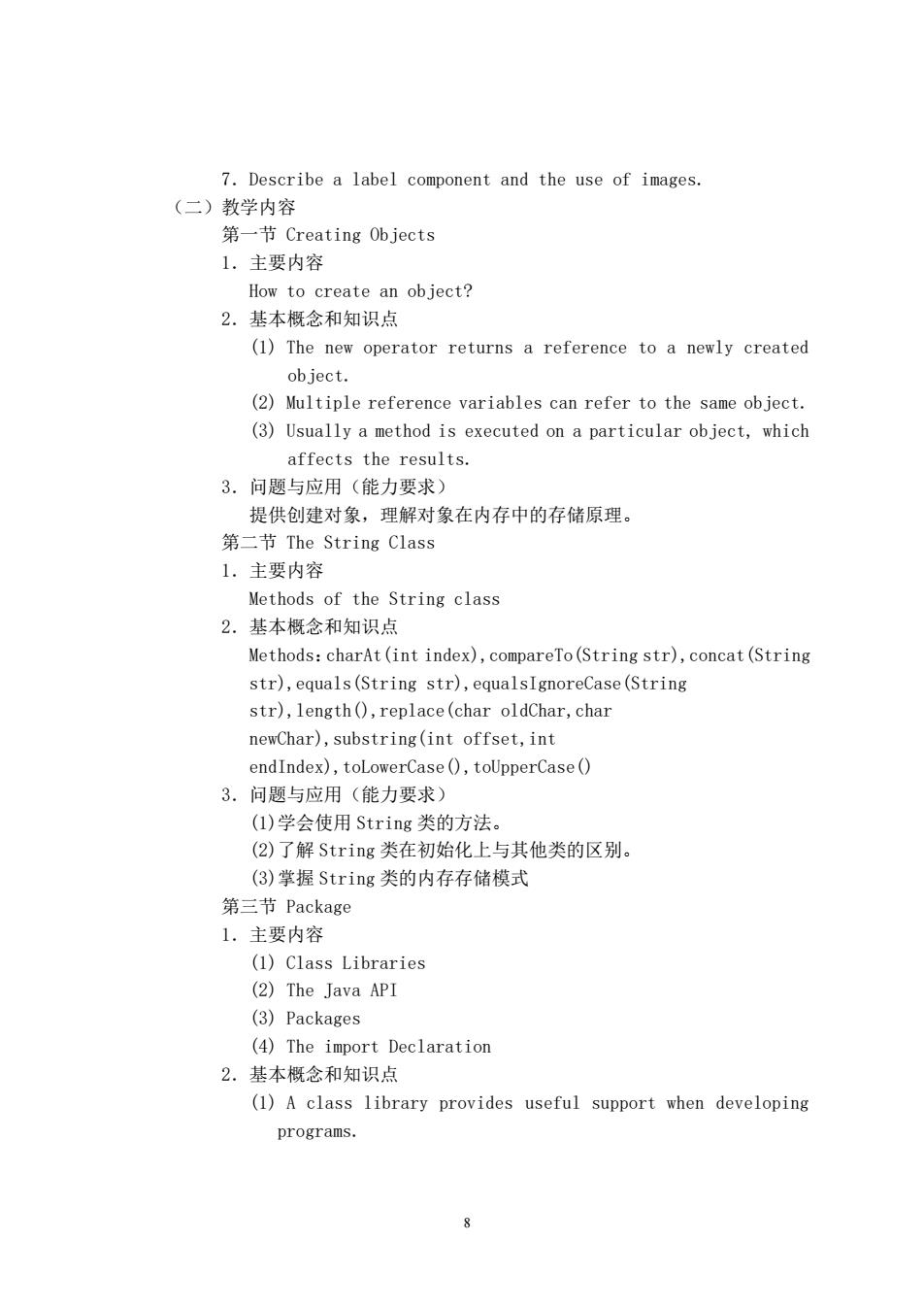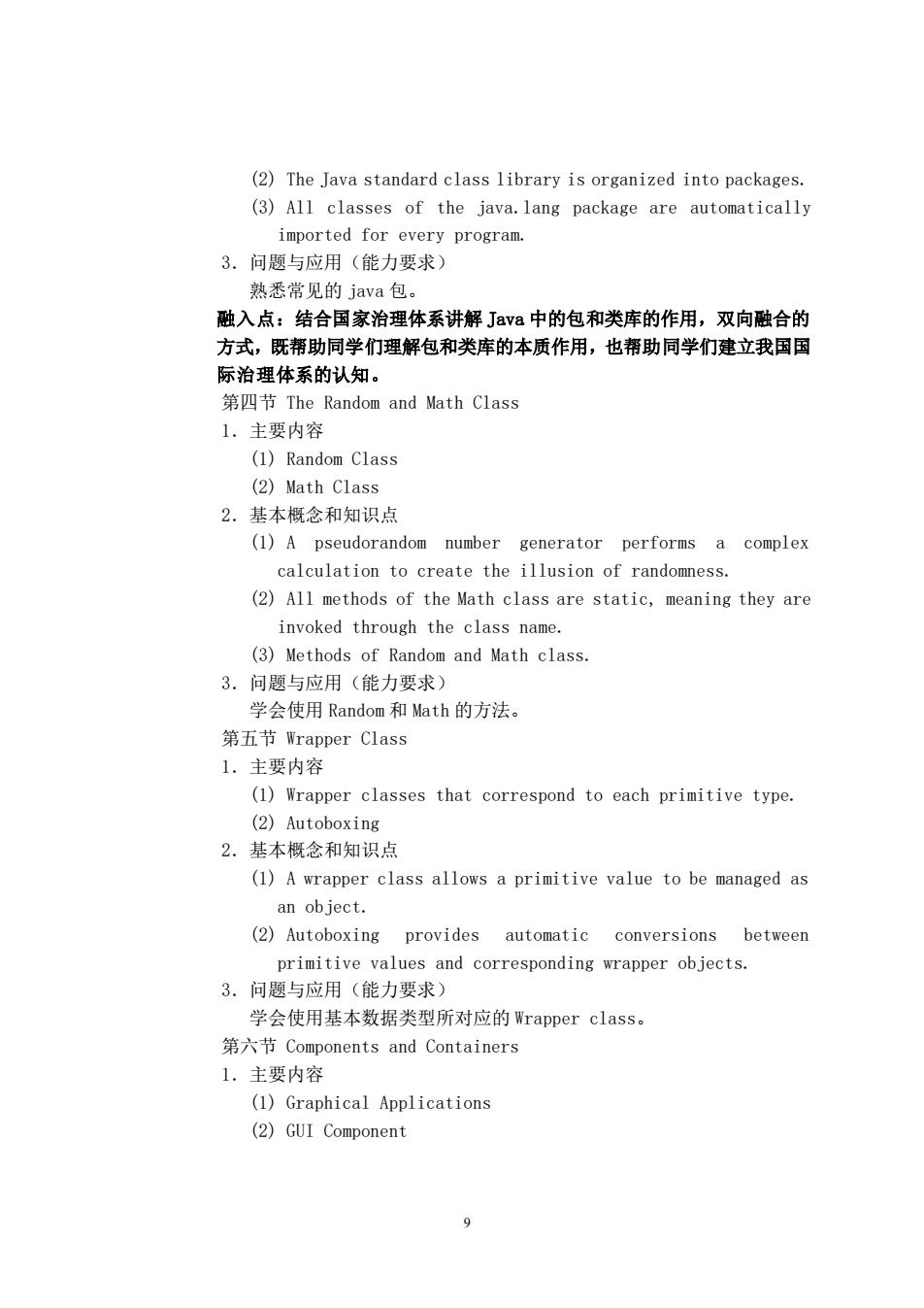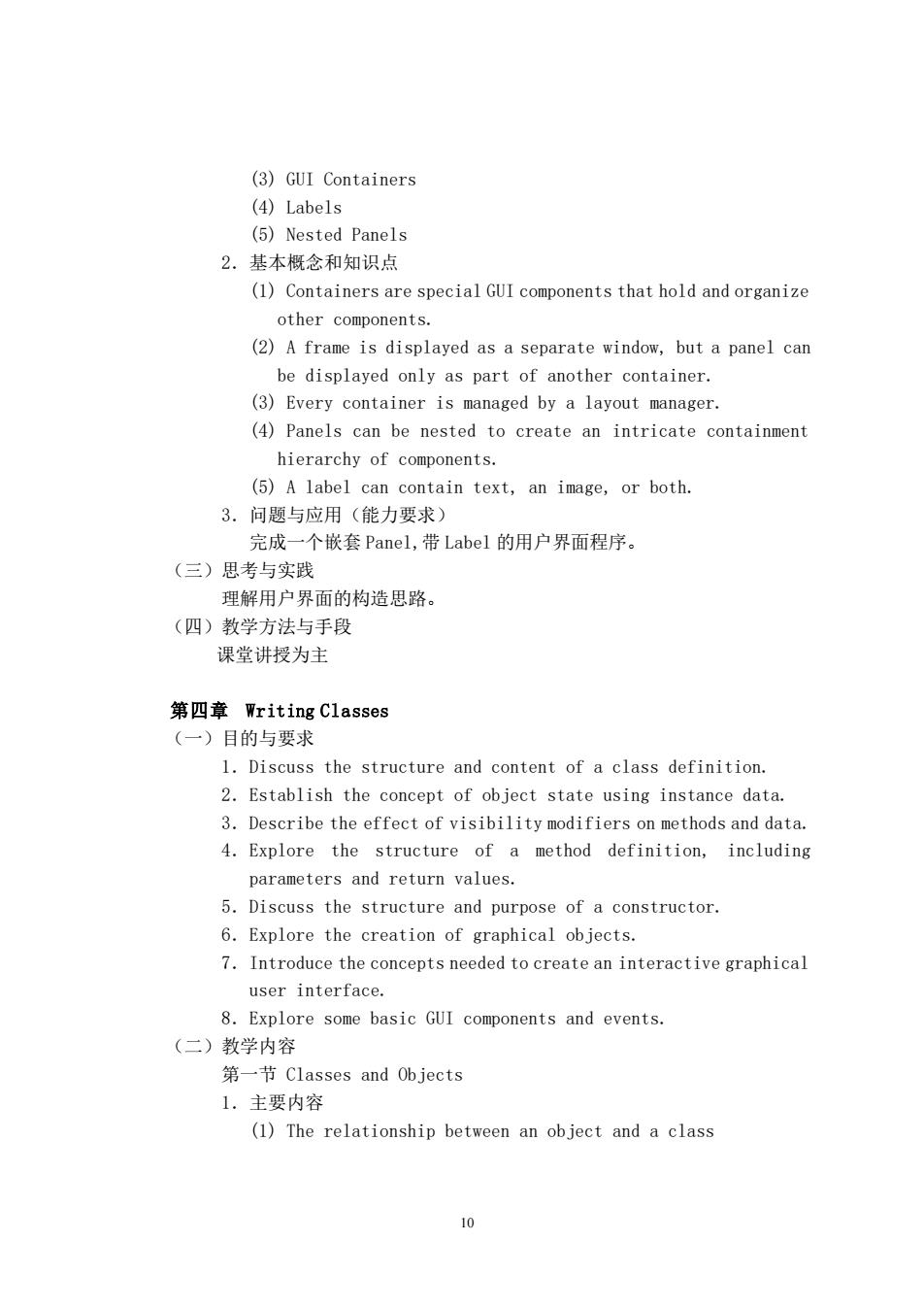
(3)We cannot assign a value of one type to a variable of an incompatible type. (4)Constants hold a particular value for the duration of their existence. 3.问题与应用(能力要求) 会正确定义变量和常量,使用赋值语句 第三节Primitive Data Types 1.主要内容 (1)Integers and Floating Points (2)Characters (3)Booleans 2.基本概念和知识点 (1)Java has two kinds of numeric values:integer and floating point.There are four integer data types and two floating point data types (2)Java uses the 16-bit Unicode character set to represent character data 3.问题与应用(能力要求) 根据基本数据类型以及其占据的内容空间合理定义变量类型 融入点: (1)数据类型定义与内存空间分配关系紧密,由空间分配引入促进人 与自然和谐共生的相关思想,引导学生思考如何在有限的空间和资源下, 达到最大的效用。 (2)结合习近平生态文明思想,探讨资源利用问题。 第四节Expressions 1.主要内容 (1)Arithmetic Operators (2)Operator Precedence (3)Increment and Decrement Operators (4)Assignment Operators 2.基本概念和知识点 (1)Expressions are combinations of operators and operands used to perform a calculation. (2)Java follows a well-defined set of precedence rules that governs the order in which operators will be evaluated in an
6 (3) We cannot assign a value of one type to a variable of an incompatible type. (4) Constants hold a particular value for the duration of their existence. 3.问题与应用(能力要求) 会正确定义变量和常量,使用赋值语句 第三节 Primitive Data Types 1.主要内容 (1) Integers and Floating Points (2) Characters (3) Booleans 2.基本概念和知识点 (1) Java has two kinds of numeric values: integer and floating point. There are four integer data types and two floating point data types. (2) Java uses the 16-bit Unicode character set to represent character data. 3.问题与应用(能力要求) 根据基本数据类型以及其占据的内容空间合理定义变量类型 融入点: (1)数据类型定义与内存空间分配关系紧密,由空间分配引入促进人 与自然和谐共生的相关思想,引导学生思考如何在有限的空间和资源下, 达到最大的效用。 (2)结合习近平生态文明思想,探讨资源利用问题。 第四节 Expressions 1.主要内容 (1) Arithmetic Operators (2) Operator Precedence (3) Increment and Decrement Operators (4) Assignment Operators 2.基本概念和知识点 (1) Expressions are combinations of operators and operands used to perform a calculation. (2) Java follows a well-defined set of precedence rules that governs the order in which operators will be evaluated in an

expression. 3.问题与应用(能力要求 掌握表达式的优先级 第五节Data Conversion 1.主要内容 (1)Conversion Techniques 2.基本概念和知识点 (1)Narrowing conversions (2)Widening conversions 3.问题与应用(能力要求) 掌握什么情况下用narrowing和widening conversion 第六节Interactive Programs 1.主要内容 The Scanner Class 2.基本概念和知识点 The Scanner class provides methods for reading input of various types from various sources. 3.问题与应用(能力要求) 掌握Scanner类的使用方法 (三)思考与实践 利用Scanner类与屏幕交互,计算表达式结果,并在屏幕输出。 (四)教学方法与手段 课堂讲授为主。 第三章Using Classes and0 bjects (一)目的与要求 1.Discuss the creation of objects and the use of object reference variables. 2.Explore the services provided by the String class. 3.Describe how the Java standard class library is organized into packages 4.Explore the services provided by the Random and Math classes. 5.Discuss wrapper classes and the concept of autoboxing. 6.Introduce components and containers used in graphical user interfaces. 7
7 expression. 3.问题与应用(能力要求) 掌握表达式的优先级 第五节 Data Conversion 1.主要内容 (1) Conversion Techniques 2.基本概念和知识点 (1) Narrowing conversions (2) Widening conversions 3.问题与应用(能力要求) 掌握什么情况下用 narrowing 和 widening conversion 第六节 Interactive Programs 1.主要内容 The Scanner Class 2.基本概念和知识点 The Scanner class provides methods for reading input of various types from various sources. 3.问题与应用(能力要求) 掌握 Scanner 类的使用方法 (三)思考与实践 利用 Scanner 类与屏幕交互,计算表达式结果,并在屏幕输出。 (四)教学方法与手段 课堂讲授为主。 第三章 Using Classes and Objects (一)目的与要求 1.Discuss the creation of objects and the use of object reference variables. 2.Explore the services provided by the String class. 3.Describe how the Java standard class library is organized into packages. 4.Explore the services provided by the Random and Math classes. 5.Discuss wrapper classes and the concept of autoboxing. 6.Introduce components and containers used in graphical user interfaces

7.Describe a label component and the use of images. (二)教学内容 第一节Creating ob iects 1,主要内容 How to create an obiect? 2.基本概念和知识点 (1)The new operator returns a reference to a newly created object. (2)Multiple reference variables can refer to the same object. (3)Usually a method is executed on a particular object,which affects the results. 3.问题与应用(能力要求) 提供创建对象,理解对象在内存中的存储原理。 第二节The String Class 1.主要内容 Methods of the String class 2.基本概念和知识点 Methods:charAt(int index),compareTo(String str),concat(String str),equals(String str),equalsIgnoreCase(String str),length(),replace(char oldChar,char newChar),substring(int offset,int endIndex),toLowerCase(),toUpperCase() 3.问题与应用(能力要求) (1)学会使用String类的方法。 (2)了解String类在初始化上与其他类的区别, (3)学握String类的内存存储模式 第三节Package 1,主要内容 (1)Class Libraries (2)The Java API (3)Packages (4)The import Declaration 2.基本概念和知识点 (1)A class library provides useful support when developing programs
8 7.Describe a label component and the use of images. (二)教学内容 第一节 Creating Objects 1.主要内容 How to create an object? 2.基本概念和知识点 (1) The new operator returns a reference to a newly created object. (2) Multiple reference variables can refer to the same object. (3) Usually a method is executed on a particular object, which affects the results. 3.问题与应用(能力要求) 提供创建对象,理解对象在内存中的存储原理。 第二节 The String Class 1.主要内容 Methods of the String class 2.基本概念和知识点 Methods:charAt(int index),compareTo(String str),concat(String str),equals(String str),equalsIgnoreCase(String str),length(),replace(char oldChar,char newChar),substring(int offset,int endIndex),toLowerCase(),toUpperCase() 3.问题与应用(能力要求) (1)学会使用 String 类的方法。 (2)了解 String 类在初始化上与其他类的区别。 (3)掌握 String 类的内存存储模式 第三节 Package 1.主要内容 (1) Class Libraries (2) The Java API (3) Packages (4) The import Declaration 2.基本概念和知识点 (1) A class library provides useful support when developing programs

(2)The Java standard class library is organized into packages. (3)All classes of the java.lang package are automatically imported for every program. 3.问题与应用(能力要求 熟悉常见的java包。 融入点:结合国家治理体系讲解Java中的包和类库的作用,双向融合的 方式,既帮助同学们理解包和类库的本质作用,也帮助同学们建立我国国 际治理体系的认知。 第四节The Random and Math Class 1.主要内容 (1)Random Class (②)Math Class 2.基本概念和知识点 (1)A pseudorandom number generator performs a complex calculation to create the illusion of randomness (2)All methods of the Math class are static,meaning they are invoked through the class name. (3)Methods of Random and Math class. 3.问题与应用(能力要求) 学会使用Random和Math的方法。 第五节Wrapper Class 1.主要内容 (1)Wrapper classes that correspond to each primitive type. (2)Autoboxing 2.基本概念和知识点 (1)A wrapper class allows a primitive value to be managed as an object (2)Autoboxing provides automatic conversions between primitive values and corresponding wrapper objects. 3.问题与应用(能力要求) 学会使用基本数据类型所对应的Wrapper class。 第六节Components and Containers 1.主要内容 (1)Graphical Applications (2)GUI Component 9
9 (2) The Java standard class library is organized into packages. (3) All classes of the java.lang package are automatically imported for every program. 3.问题与应用(能力要求) 熟悉常见的 java 包。 融入点:结合国家治理体系讲解 Java 中的包和类库的作用,双向融合的 方式,既帮助同学们理解包和类库的本质作用,也帮助同学们建立我国国 际治理体系的认知。 第四节 The Random and Math Class 1.主要内容 (1) Random Class (2) Math Class 2.基本概念和知识点 (1) A pseudorandom number generator performs a complex calculation to create the illusion of randomness. (2) All methods of the Math class are static, meaning they are invoked through the class name. (3) Methods of Random and Math class. 3.问题与应用(能力要求) 学会使用 Random 和 Math 的方法。 第五节 Wrapper Class 1.主要内容 (1) Wrapper classes that correspond to each primitive type. (2) Autoboxing 2.基本概念和知识点 (1) A wrapper class allows a primitive value to be managed as an object. (2) Autoboxing provides automatic conversions between primitive values and corresponding wrapper objects. 3.问题与应用(能力要求) 学会使用基本数据类型所对应的 Wrapper class。 第六节 Components and Containers 1.主要内容 (1) Graphical Applications (2) GUI Component

(3)GUI Containers (4)Labels (5)Nested Panels 2.基本概念和知识点 (1)Containers are special GUI components that hold and organize other components. (2)A frame is displayed as a separate window,but a panel can be displayed only as part of another container. (3)Every container is managed by a layout manager. (4)Panels can be nested to create an intricate containment hierarchy of components. (5)A label can contain text,an image,or both. 3.问题与应用(能力要求) 完成个嵌套Panel,带Label的用户界面程序。 (三)思考与实践 理解用户界面的构造思路。 (四)教学方法与手段 课堂讲授为主 第四章Writing Classes (一)目的与要求 1.Discuss the structure and content of a class definition. 2.Establish the concept of object state using instance data 3.Describe the effect of visibility modifiers on methods and data 4.Explore the structure of a method definition,including parameters and return values. 5.Discuss the structure and purpose of a constructor. 6.Explore the creation of graphical objects. 7.Introduce the concepts needed to create an interactive graphical user interface. 8.Explore some basic GUI components and events. (二)教学内容 第-节Classes and Objects 1.主要内容 (1)The relationship between an object and a class 10
10 (3) GUI Containers (4) Labels (5) Nested Panels 2.基本概念和知识点 (1) Containers are special GUI components that hold and organize other components. (2) A frame is displayed as a separate window, but a panel can be displayed only as part of another container. (3) Every container is managed by a layout manager. (4) Panels can be nested to create an intricate containment hierarchy of components. (5) A label can contain text, an image, or both. 3.问题与应用(能力要求) 完成一个嵌套 Panel,带 Label 的用户界面程序。 (三)思考与实践 理解用户界面的构造思路。 (四)教学方法与手段 课堂讲授为主 第四章 Writing Classes (一)目的与要求 1.Discuss the structure and content of a class definition. 2.Establish the concept of object state using instance data. 3.Describe the effect of visibility modifiers on methods and data. 4.Explore the structure of a method definition, including parameters and return values. 5.Discuss the structure and purpose of a constructor. 6.Explore the creation of graphical objects. 7.Introduce the concepts needed to create an interactive graphical user interface. 8.Explore some basic GUI components and events. (二)教学内容 第一节 Classes and Objects 1.主要内容 (1) The relationship between an object and a class